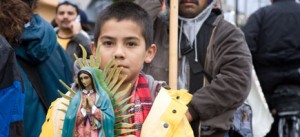Sacred, Secular Images of Guadalupe Proliferate
It’s common to see images of Our Lady of Guadalupe on T-shirts, watches, bracelets, key chains, paintings, murals and even tattoos. Devotion to the patron saint of Mexico, whose feast day is Dec. 12, is strong among Latin American Catholics.
Use of those images “is an expression that brings the sacred to everyday life,” said theologian Nancy Pineda Madrid, a professor at the Institute of Religious Education and Pastoral Ministry at Boston College. “Having her with us is a way to feel more secure, more confident in life, especially when we have problems or are in danger.”
Father Ricardo Chavez shares that view. He is an expert in the Guadalupe devotion, and retired this year from St. Peter Martyr of Verona Parish in Pittsburg. “I think any use of the image of the Virgin is based on our belief and hope that she is always with us, especially in difficult times when we feel the oppression of society or any group,” he said.
When Our Lady of Guadalupe appeared to the indigenous peasant Juan Diego in 1531 on a hill outside of what is now Mexico City, the community was living in very difficult times. It was the vision and message of the mother of God that brought them hope, Father Chavez said.
“On one side the Virgin has been a religious icon and it shows the fervor and faith that people have in it since they started to worship in the 16th century. But she has also been a political symbol,” said Maria Luisa Ruiz, professor of modern languages at Saint Mary’s College of California.
“The priest Miguel Hidalgo y Costilla used the image of the Virgin of Guadalupe as the standard for the battles of independence,” she said. “During the Mexican revolution her image was also used by Emiliano Zapata and other revolutionaries. And today, almost 500 years later, her presence remains important as it inspires political activism.”
“It became an active image used to fight for the basic rights of individuals, and marginalized groups were inspired to use it as an emblem of their struggle,” she said.
In the 1960s, the image was used to help create a more equitable workplace through Cesar Chavez and Dolores Huerta. The founders of the United Farm Workers union used the image of the Virgin in their activism for the rights of farm workers.
“The Virgin of Guadalupe has been an icon in the peasants’ struggle,” said Juana Alicia Montoya, a former UFW member who worked with Cesar Chavez. “It symbolizes a humble woman, a farmer and is very strong.
“We look to her as a woman leader and that comes through the leadership of Dolores Huerta, co-founder of the farm workers union,” Montoya said. “That spurred the Chicano to analyze our role as women…and we can have a role in the liberation of the people in the mass struggle, challenging our traditional role.”
Many people have claimed the image of the Virgin of Guadalupe as their own, Montoya said. “It does not belong only to the Catholic Church but belongs to different groups, unions, feminists, merchants – they all want to use her, even drug dealers and gangs seeking protection.”
Jason Stein, who works at a tattoo shop in San Francisco, has made at least 40 tattoos of Our Lady of Guadalupe in recent years, mostly on Latino men. “It’s a very popular image. The person can be Catholic, Jewish or any religion, but they request it because it is a very powerful symbol,” he said.
Stein says many of his clients want the tattoo because they believe in the tradition and want to show their devotion. Others use it as a symbol of power, but he discounted that its use was linked to gangs.
Although the Church has not taken an official position against such tattoos, theologian Pineda Madrid says it has become a popular religious trend for people to take this sacred image into their daily lives.
“Don’t think we are promoting the tattoos,” she said. “We respect the sacredness and are discerning about how we use the images. A soldier in the war, for instance, might have the Virgin of Guadalupe tattooed on him because he seeks her protection, but it isn’t the same with those who would use the images to do evil.”
From December 3, 2010 issue of Catholic San Francisco.
[Used by permission of Catholic SF] [Photo by Jose Luis Aguirre/Catholic San Francisco]

